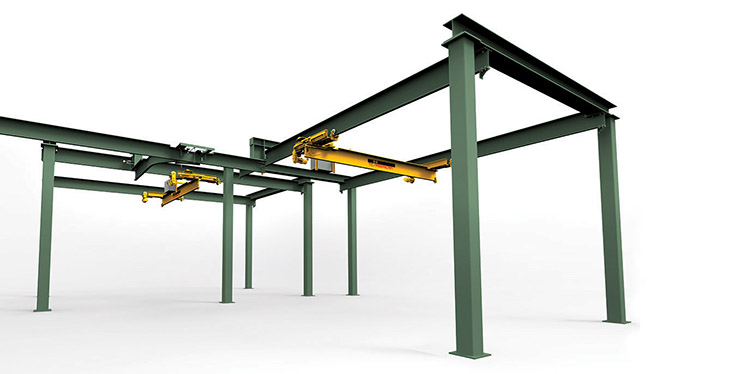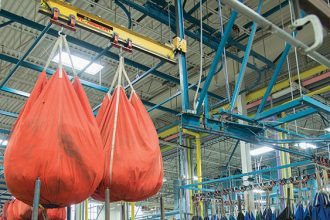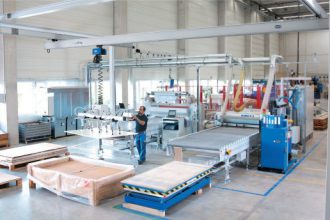The “Dos And Don’ts” Of Workstation Cranes

Workstation cranes — offered in jib, bridge, and gantry styles — are often deployed in manufacturing and assembly operations where operators must lift, handle, and move heavy objects as part of a work process. Generally handling loads ranging from 150 to 4,000 pounds, these cranes are dedicated to a specific area or location and are equipped with a load handling device, such as a hoist, that suspends the load. This makes it less strenuous for an operator to lift, lower, position, turn, or move the workpiece.
While workstation cranes improve ergonomics, handling efficiency, and productivity, to ensure their safest use, operations planning to add one to their facility (or those with one or more workstation cranes already in use) have a variety of responsibilities that are critical to the safe operation of this equipment. That’s why the Monorail Manufacturers Association (MMA) publishes multiple specifications and recommended practices for the design, operation and service of cranes. In addition, the members of MMA have also assembled a list of workstation crane equipment “Dos and Don’ts.” Following these recommendations will enhance both the integrity and reliability of the equipment, as well as reduce the risk of injury for workers as they operate the system or work in proximity to it.
Workstation Crane Equipment Dos…
- Do ensure that the workstation crane and lifting device are properly sized to handle the load when specifying/purchasing the equipment. Choosing a hoist or other lifting device that is sufficient (or slightly more so) for the lifting speed and weight capacity needed means that the entire workstation crane is sized correctly for the application.
- Do verify during the design phase that the load will be free to move and to clear all obstructions.
- Do confirm that load travel is in the same direction as shown on controls.
- Do read the owner’s manual. These informational documents — developed by the workstation crane’s manufacturer — contain specifications, dimensions, operation instructions, inspection criteria, parts lists, and more.
- Do understand that the Occupational Safety and Health Administration (OSHA) requires facility operators to provide their employees with equipment that is both safe and operates property.
- Do inspect the workstation crane prior to the start of each shift before operation, as well as at frequent and periodic intervals.
- Do report damage, malfunctions, or unusual performance of the workstation crane to managers immediately.
- Do ensure all employees/operators who will use the workstation crane have been trained on its proper use and operation by someone who has experience with the equipment.
- Do follow all safety precautions specified by the manufacturer of the crane when operating the equipment.
- Do operate the workstation crane properly and safely, ensuring the following prior to and during use:
- Proper sizing of load slings or attachments
- Familiarity with operating controls, procedures and warnings
- Secure attachment of the unit to a suitable support prior to applying the load
- Careful take-up of slack, verifying that the load is balanced and load holding action secure before lifting
- Confirm all personnel are clear of the supported load
- Verify that end stops and/or travel limit switches work properly
- Warn other personnel of an approaching load
- Maintain a firm footing when operating the system
- Avoid swinging the load or hook
- Check brake functions by tensioning the load before lifting
- Do perform regular preventive maintenance, including lubrication, as specified by the workstation crane manufacturer to ensure long service life.
- Do engage independent service and inspection professionals with experience on the specific equipment if outsourcing preventive maintenance and repairs.
Workstation Crane Equipment Don’ts…
- Do not buy a workstation crane that is undersized or oversized for the application. While it may save on the initial investment, an undersized workstation crane and lifting device will be prone to more frequent breakdowns and premature replacement of key components. Conversely, an oversized lifting device will require upsizing of the bridge and runway, creating an overall heavier system. This requires the operator to apply more ergonomic force, as well as can significantly increase the system’s cost.
- Do not misplace or throw away the owner’s manual. This document is a critical resource for owners and operators of workstation cranes.
- Do not install the workstation crane in a location where it will be subjected to interference or contact from other systems, structures, or objects.
- Do not allow untrained operators to use the workstation crane.
- Do not attempt to operate a workstation crane that has been tagged out-of-service.
- Do not allow an operator to attach a load without first having proper training.
- Do not attempt to lift a load that exceeds the capacity rating of the workstation crane.
- Do not use a workstation crane whose lifting attachment or hoist has a twisted, kinked, damaged or worn wire rope or chain.
- Do not operate the workstation crane unless the load is centered first.
- Do not use limit switches and end stops as a routine method to stop load movement; this will cause premature wear of the components.
- Do not use the workstation crane for any purpose outside its specified function, including lifting, supporting, or transporting people.
- Do not lift or move loads over people.
- Do not leave a load supported by the workstation crane unless specific precautions have been taken.
- Do not allow an operator’s attention to be diverted during operation of the workstation crane.
Looking for more information on workstation cranes? Consult the members of the Monorail Manufacturers Association (MMA), who are the industry’s leading suppliers of monorails and workstation cranes. Available to answer any questions, the group also offers a variety of resources — including a product certification program, recommended practices for workstation cranes and patented track systems, and more — via its website at www.MHI.org/MMA.



